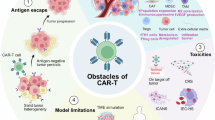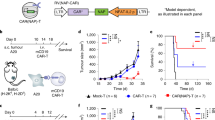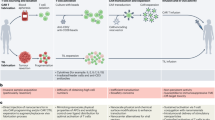Abstract
Chimeric antigen receptor (CAR) T cell therapy has revolutionized the treatment of haematological malignancies. Challenges in overcoming physical barriers however greatly limit CAR-T cell efficacy in solid tumours. Here we show that an approach based on collagenase nanogel generally improves the outcome of T cell-based therapies, and specifically of CAR-T cell therapy. The nanogels are created by cross-linking collagenase and subsequently modifying them with a CXCR4 antagonist peptide. These nanogels can bind CAR-T cells via receptor–ligand interaction, resulting in cellular backpack delivery systems. The nanogel backpacks modulate tumoural infiltration and localization of CAR-T cells by surmounting physical barriers and disrupting chemokine-mediated CAR-T cell imprisonment, thereby addressing their navigation deficiency within solid tumours. Our approach offers a promising strategy for pancreatic cancer therapy and holds potential for advancing CAR-T cell therapy towards clinical applications.
This is a preview of subscription content, access via your institution
Access options
Access Nature and 54 other Nature Portfolio journals
Get Nature+, our best-value online-access subscription
$32.99 / 30 days
cancel any time
Subscribe to this journal
Receive 12 print issues and online access
$259.00 per year
only $21.58 per issue
Buy this article
- Purchase on SpringerLink
- Instant access to full article PDF
Prices may be subject to local taxes which are calculated during checkout






Similar content being viewed by others
Data availability
The authors declare that all of the data supporting the results are available in this paper and the Supplementary Information. Source data are provided with this paper.
References
Maude, S. L. et al. Tisagenlecleucel in children and young adults with B-cell lymphoblastic leukemia. N. Engl. J. Med. 378, 439–448 (2018).
Neelapu, S. S. et al. Axicabtagene ciloleucel CAR T-cell therapy in refractory large B-cell lymphoma. N. Engl. J. Med. 377, 2531–2544 (2017).
Schuster, S. J. et al. Chimeric antigen receptor T cells in refractory B-cell lymphomas. N. Engl. J. Med. 377, 2545–2554 (2017).
Beatty, G. L. et al. Activity of mesothelin-specific chimeric antigen receptor T cells against pancreatic carcinoma metastases in a phase 1 trial. Gastroenterology 155, 29–32 (2018).
Hou, A. J., Chen, L. C. & Chen, Y. Y. Navigating CAR-T cells through the solid-tumour microenvironment. Nat. Rev. Drug Discov. 20, 531–550 (2021).
Newick, K., O’Brien, S., Moon, E. & Albelda, S. M. CAR T cell therapy for solid tumors. Annu. Rev. Med. 68, 139–152 (2017).
Beatty, G. L. et al. Mesothelin-specific chimeric antigen receptor mRNA-engineered T cells induce antitumor activity in solid malignancies. Cancer Immunol. Res. 2, 112–120 (2014).
Haas, A. R. et al. Phase I study of lentiviral-transduced chimeric antigen receptor-modified T cells recognizing mesothelin in advanced solid cancers. Mol. Ther. 27, 1919–1929 (2019).
Maus, M. V. et al. T cells expressing chimeric antigen receptors can cause anaphylaxis in humans. Cancer Immunol. Res. 1, 26–31 (2013).
Nagarsheth, N., Wicha, M. S. & Zou, W. Chemokines in the cancer microenvironment and their relevance in cancer immunotherapy. Nat. Rev. Immunol. 17, 559–572 (2017).
Valkenburg, K. C., de Groot, A. E. & Pienta, K. J. Targeting the tumour stroma to improve cancer therapy. Nat. Rev. Clin. Oncol. 15, 366–381 (2018).
Lesch, S. et al. T cells armed with C-X-C chemokine receptor type 6 enhance adoptive cell therapy for pancreatic tumours. Nat. Biomed. Eng. 5, 1246–1260 (2021).
Albelda, S. M. CAR T cell therapy for patients with solid tumours: key lessons to learn and unlearn. Nat. Rev. Clin. Oncol. 21, 47–66 (2024).
Ho, W. J., Jaffee, E. M. & Zheng, L. The tumour microenvironment in pancreatic cancer—clinical challenges and opportunities. Nat. Rev. Clin. Oncol. 17, 527–540 (2020).
Pandol, S., Edderkaoui, M., Gukovsky, I., Lugea, A. & Gukovskaya, A. Desmoplasia of pancreatic ductal adenocarcinoma. Clin. Gastroenterol. Hepatol. 7, S44–S47 (2009).
Blando, J. et al. Comparison of immune infiltrates in melanoma and pancreatic cancer highlights VISTA as a potential target in pancreatic cancer. Proc. Natl Acad. Sci. USA 116, 1692–1697 (2019).
Tian, C. et al. Proteomic analyses of ECM during pancreatic ductal adenocarcinoma progression reveal different contributions by tumor and stromal cells. Proc. Natl Acad. Sci. USA 116, 19609–19618 (2019).
Watt, J. & Kocher, H. M. The desmoplastic stroma of pancreatic cancer is a barrier to immune cell infiltration. OncoImmunology https://doi.org/10.4161/onci.26788 (2014).
Cox, T. R. The matrix in cancer. Nat. Rev. Cancer 21, 217–238 (2021).
Peranzoni, E., Rivas-Caicedo, A., Bougherara, H., Salmon, H. & Donnadieu, E. Positive and negative influence of the matrix architecture on antitumor immune surveillance. Cell. Mol. Life Sci. 70, 4431–4448 (2013).
Acerbi, I. et al. Human breast cancer invasion and aggression correlates with ECM stiffening and immune cell infiltration. Integr. Biol. 7, 1120–1134 (2015).
Sahai, E. et al. A framework for advancing our understanding of cancer-associated fibroblasts. Nat. Rev. Cancer 20, 174–186 (2020).
Rhim, A. D. et al. Stromal elements act to restrain, rather than support, pancreatic ductal adenocarcinoma. Cancer Cell 25, 735–747 (2014).
Biasci, D. et al. CXCR4 inhibition in human pancreatic and colorectal cancers induces an integrated immune response. Proc. Natl Acad. Sci. USA 117, 28960–28970 (2020).
Bockorny, B. et al. BL-8040, a CXCR4 antagonist, in combination with pembrolizumab and chemotherapy for pancreatic cancer: the COMBAT trial. Nat. Med. 26, 878–885 (2020).
Feig, C. et al. Targeting CXCL12 from FAP-expressing carcinoma-associated fibroblasts synergizes with anti-PD-L1 immunotherapy in pancreatic cancer. Proc. Natl Acad. Sci. USA 110, 20212–20217 (2013).
Ene-Obong, A. et al. Activated pancreatic stellate cells sequester CD8+ T cells to reduce their infiltration of the juxtatumoral compartment of pancreatic ductal adenocarcinoma. Gastroenterology 145, 1121–1132 (2013).
Wang, Z. et al. Carcinomas assemble a filamentous CXCL12-keratin-19 coating that suppresses T cell-mediated immune attack. Proc. Natl Acad. Sci. USA https://doi.org/10.1073/pnas.2119463119 (2022).
Dolor, A. & Szoka, F. C. Digesting a path forward: the utility of collagenase tumor treatment for improved drug delivery. Mol. Pharm. 15, 2069–2083 (2018).
Zinger, A. et al. Collagenase nanoparticles enhance the penetration of drugs into pancreatic tumors. ACS Nano 13, 11008–11021 (2019).
Wang, L. et al. Enhanced intracellular transcytosis of nanoparticles by degrading extracellular matrix for deep tissue radiotherapy of pancreatic adenocarcinoma. Nano Lett. 22, 6877–6887 (2022).
Zhou, N. et al. Exploring the stereochemistry of CXCR4-peptide recognition and inhibiting HIV-1 entry with d-peptides derived from chemokines. J. Biol. Chem. 277, 17476–17485 (2002).
Ansari, S., Mudassir, M., Vijayalekshmi, B. & Chattopadhyay, P. Targeting CXCR4-expressing cancer cells with avidin-poly (lactic-co-glycolic acid) nanoparticle surface modified with biotinylated DV1 peptide. Int. J. Appl. Basic Med. Res. 13, 106–112 (2023).
Houg, D. S. & Bijlsma, M. F. The hepatic pre-metastatic niche in pancreatic ductal adenocarcinoma. Mol. Cancer https://doi.org/10.1186/s12943-018-0842-9 (2018).
Saur, D. et al. CXCR4 expression increases liver and lung metastasis in a mouse model of pancreatic cancer. Gastroenterology 129, 1237–1250 (2005).
Xie, Y. et al. Stromal modulation and treatment of metastatic pancreatic cancer with local intraperitoneal triple miRNA/siRNA nanotherapy. ACS Nano 14, 255–271 (2020).
Zhao, H. & Heindel, N. D. Determination of degree of substitution of formyl groups in polyaldehyde dextran by the hydroxylamine hydrochloride method. Pharm. Res. 8, 400–402 (1991).
Qian, D. et al. Galectin-1-driven upregulation of SDF-1 on pancreatic stellate cells promotes pancreatic cancer metastasis. Cancer Lett. 397, 43–51 (2017).
Kato, M., Hattori, Y., Kubo, M. & Maitani, Y. Collagenase-1 injection improved tumor distribution and gene expression of cationic lipoplex. Int. J. Pharm. 423, 428–434 (2012).
Diener, B., Carrick, L. Jr. & Berk, R. S. In vivo studies with collagenase from Pseudomonas aeruginosa. Infect. Immun. 7, 212–217 (1973).
Rosenberg, S. A. & Restifo, N. P. Adoptive cell transfer as personalized immunotherapy for human cancer. Science 348, 62–68 (2015).
Wehrli, M. et al. Mesothelin CAR T cells secreting anti-FAP/anti-CD3 molecules efficiently target pancreatic adenocarcinoma and its stroma. Clin. Cancer Res. 30, 1859–1877 (2024).
Lee, H. H. et al. Therapeutic efficacy of T cells expressing chimeric antigen receptor derived from a mesothelin-specific scFv in orthotopic human pancreatic cancer animal models. Neoplasia 24, 98–108 (2022).
Adler-Nissen, J. Determination of the degree of hydrolysis of food protein hydrolysates by trinitrobenzenesulfonic acid. J. Agric. Food Chem. 27, 1256–1262 (1979).
Acknowledgements
This work was financially supported by the National Natural Science Foundation of China (NSFC, numbers 22272091 (Y.L.), U24A20732 (Y.L.) and 82061148009 (Y.L.)). We acknowledge Y. Cheng and Q. Song from the Qilu Hospital of Shandong University for their technical assistance. The Pharmaceutical Biology Sharing Platform and the Advanced Medical Research Institute of Shandong University are acknowledged.
Author information
Authors and Affiliations
Contributions
Z.Z., Q.L. and Y.L. designed the project. Z.Z., Q.L. and Z.J. performed the in vitro cell experiments. G.J. and G.L. assisted in performing the in vivo imaging experiment. Z.Z., Q.L. and C.Q. achieved the in vivo anti-tumour evaluation. Z.Z. and Y.L. wrote the paper. All authors analysed the data, discussed the results and reviewed the paper.
Corresponding author
Ethics declarations
Competing interests
Z.Z., Q.L. and Y.L. are the inventors of the patents (CN202410362842.5; US18/619,282) related to this research filed by Shandong University. The other authors declare no competing interests.
Peer review
Peer review information
Nature Nanotechnology thanks Shiba Ansari, Yevgeny Brudno and Navin Varadarajan for their contribution to the peer review of this work.
Additional information
Publisher’s note Springer Nature remains neutral with regard to jurisdictional claims in published maps and institutional affiliations.
Extended data
Extended Data Fig. 1 DV1@O-Colase nanogels potentiated the anti-tumor therapy of αPD-1.
a, Schematic diagram for the experimental protocols of anti-tumor evaluation of DV1@O-Colase nanogels in combination with anti-PD-1 therapy. b, Representative bioluminescence images and c, quantification of bioluminescence intensity of tumor growth in C57BL/6 mice during therapy (n = 5 biologically independent mice). d, The body weight of mice during therapy (n = 5 biologically independent mice). e, Representative FCM scatter blots and quantification of the frequency of CD8+ T cells in tumors (n = 5 biologically independent mice). f, Representative FCM scatter blots and quantification of the expression of granzyme B in tumor infiltrating CD8+ T cells (n = 5 biologically independent mice). g, Representative FCM scatter blots and quantification of the expression of IFN-γ in tumor infiltrating CD4+ T cells (n = 5 biologically independent mice). h, Representative FCM scatter blots and quantification of the frequency of Tregs in tumors (n = 5 biologically independent mice). i, Representative FCM scatter blots and quantification of the frequency of MDSCs in tumors (n = 5 biologically independent mice). Data in e–i were recorded in another parallel experiment of b. The experiments were repeated twice independently, with similar results (b–i). Data in c–i were presented as mean ± SD. P values were determined by two-way ANOVA test (c) or one-way ANOVA test (e–i). **P < 0.01, ****P < 0.0001.
Supplementary information
Supplementary Information
Supplementary Figs. 1–31 and Tables 1–3.
Supplementary Data 1
Source data for Supplementary figures.
Source data
Source Data Fig. 2
Statistical source data.
Source Data Fig. 3
Statistical source data.
Source Data Fig. 4
Statistical source data.
Source Data Fig. 5
Statistical source data.
Source Data Fig. 6
Statistical source data.
Source Data Extended Data Fig. 1
Statistical source data.
Rights and permissions
Springer Nature or its licensor (e.g. a society or other partner) holds exclusive rights to this article under a publishing agreement with the author(s) or other rightsholder(s); author self-archiving of the accepted manuscript version of this article is solely governed by the terms of such publishing agreement and applicable law.
About this article
Cite this article
Zhao, Z., Li, Q., Qu, C. et al. A collagenase nanogel backpack improves CAR-T cell therapy outcomes in pancreatic cancer. Nat. Nanotechnol. 20, 1131–1141 (2025). https://doi.org/10.1038/s41565-025-01924-1
Received:
Accepted:
Published:
Issue date:
DOI: https://doi.org/10.1038/s41565-025-01924-1
This article is cited by
-
Nanotechnology for CAR T cells and tumour-infiltrating lymphocyte therapies
Nature Nanotechnology (2025)
-
Nattokinase-driven remodeling of tumor microenvironment enhances the efficacy of MSLN-targeted CAR-T cell therapy in solid tumors
Cancer Immunology, Immunotherapy (2025)



